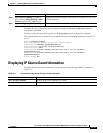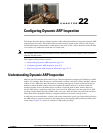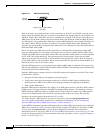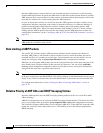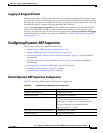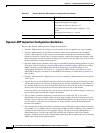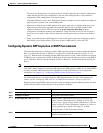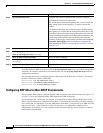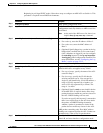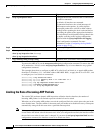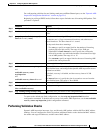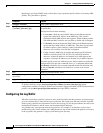
22-7
Cisco Catalyst Switch Module 3110 and 3012 for IBM BladeCenter Software Configuration Guide
OL-12189-01
Chapter 22 Configuring Dynamic ARP Inspection
Configuring Dynamic ARP Inspection
The rate of incoming packets on a physical port is checked against the port-channel configuration
rather than the physical-ports configuration. The rate-limit configuration on a port channel is
independent of the configuration on its physical ports.
If the EtherChannel receives more ARP packets than the configured rate, the channel (including all
physical ports) is placed in the error-disabled state.
• Make sure to limit the rate of ARP packets on incoming trunk ports. Configure trunk ports with
higher rates to reflect their aggregation and to handle packets across multiple dynamic ARP
inspection-enabled VLANs. You also can use the ip arp inspection limit none interface
configuration command to make the rate unlimited. A high rate-limit on one VLAN can cause a
denial-of-service attack to other VLANs when the software places the port in the error-disabled
state.
• When you enable dynamic ARP inspection on the switch, policers that were configured to police
ARP traffic are no longer effective. The result is that all ARP traffic is sent to the CPU.
Configuring Dynamic ARP Inspection in DHCP Environments
This procedure shows how to configure dynamic ARP inspection when two switches support this feature.
Host 1 is connected to Switch A, and Host 2 is connected to Switch B as shown in Figure 22-2 on
page 22-3. Both switches are running dynamic ARP inspection on VLAN 1 where the hosts are located.
A DHCP server is connected to Switch A. Both hosts acquire their IP addresses from the same DHCP
server. Therefore, Switch A has the bindings for Host 1 and Host 2, and Switch B has the binding for
Host 2.
Note Dynamic ARP inspection depends on the entries in the DHCP snooping binding database to verify
IP-to-MAC address bindings in incoming ARP requests and ARP responses. Make sure to enable DHCP
snooping to permit ARP packets that have dynamically assigned IP addresses. For configuration
information, see Chapter 21, “Configuring DHCP Features and IP Source Guard.”
For information on how to configure dynamic ARP inspection when only one switch supports the
feature, see the “Configuring ARP ACLs for Non-DHCP Environments” section on page 22-8.
Beginning in privileged EXEC mode, follow these steps to configure dynamic ARP inspection. You must
perform this procedure on both switches. This procedure is required.
Command Purpose
Step 1
show cdp neighbors Verify the connection between the switches.
Step 2
configure terminal Enter global configuration mode.
Step 3
ip arp inspection vlan vlan-range Enable dynamic ARP inspection on a per-VLAN basis. By
default, dynamic ARP inspection is disabled on all VLANs.
For vlan-range, specify a single VLAN identified by VLAN ID
number, a range of VLANs separated by a hyphen, or a series of
VLANs separated by a comma. The range is 1 to 4094.
Specify the same VLAN ID for both switches.
Step 4
interface interface-id Specify the interface connected to the other switch, and enter
interface configuration mode.



